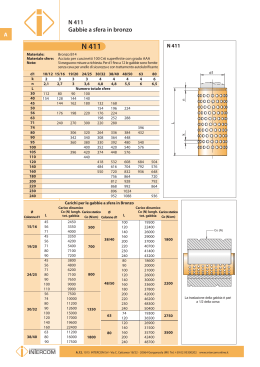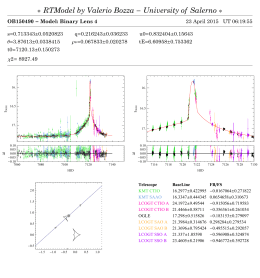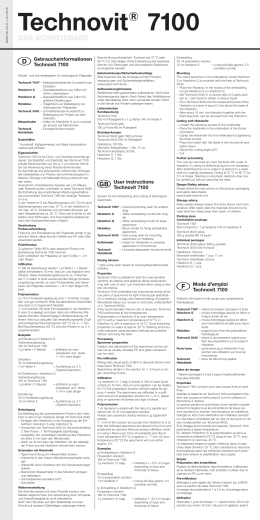OWNER MANUAL MANUALE D’USO DXT 7000 AC 7212 SYSTEM - SPARE AMPLIFIER CHANGE-OVER BOARD FOR LT 7208 - SCHEDA COMMUTAZIONE AMPLIFICATORE DI RISERVA PER LT 7208 SI 7120 - MONITORED LOGICAL INPUT BOARD FOR MU 7100 - SCHEDA INGRESSI LOGICI MONITORATI PER MU 7100 RO 7102 - DRY OUTPUT CONTACT BOARD FOR MU 7100 - SCHEDA CON RELÈ E CONTATTI “PULITI” PER MU 7100 INDEX INDICE ENGLISH SAFETY PRECAUTIONS AC 7212 - SPARE AMPLIFIER CHANGE OVER BOARD FOR LT 7208 SI 7120 - MONITORED LOGICAL INPUT BOARD FOR MU 7100 RO 7102 - DRY OUTPUT CONTACT BOARD FOR MU 7100 ITALIANO AVVERTENZE PER LA SICUREZZA AC 7212 - SCHEDA COMMUTAZIONE AMPLIFICATORE DI RISERVA PER LT 7208 SI 7120 - SCHEDA INGRESSI LOGICI MONITORATI PER MU 7100 RO 7102 - SCHEDA CON RELÈ E CONTATTI “PULITI” PER MU 7100 4 6 9 10 14 16 19 20 ENGLISH SAFETY PRECAUTIONS IMPORTANT NOTES Before connecting and using these products, please read this instruction manual carefully and keep it on hand for future reference. The manual is to be considered an integral part of these products and must accompany them when changing ownership, as a reference for correct installation and use as well as for the safety precautions. RCF S.p.A. will not assume any responsibility for the incorrect installation and / or use of these products. IMPORTANT NOTES WARNING: To prevent the risk of fire or electric shock, never expose these products to rain or humidity. WARNING SAFETY AND OPERATING PRECAUTIONS 1. All the precautions, in particular the safety ones, must be read with special attention, as they provide important information. 2. Loudspeaker lines can have a sufficiently high voltage (i.e. 100 V) to involve a risk of electrocution: complete the installation and all connections before turning the system on. 3. Assure all connections have been made correctly. 4. Protect all cables from damage; make sure they are positioned in a way that they cannot be stepped on or crushed by objects. 5. Never attempt to carry out any modifications or repairs. Contact your authorized service centre or qualified personnel when any product does not work properly. 6. Should any product emit a strange odour or even smoke, turn the system off immediately. 7. Do not connect any equipment or accessories not foreseen. 8. RCF S.p.A. strongly recommends these products are only installed by professional qualified installers (or specialised firms) who can ensure a correct installation and certify it according to the regulations in force. The entire audio system shall comply with the current standards and regulations regarding electrical systems. 9. There are numerous mechanical and electrical factors to be considered when installing a professional audio system (in addition to those which are strictly acoustic, such as sound pressure, angles of coverage, frequency response, etc.). ENGLISH 10. Hearing loss Exposure to high sound levels can cause permanent hearing loss. The acoustic pressure level that leads to hearing loss is different from person to person and depends on the duration of exposure. To prevent potentially dangerous exposure to high levels of acoustic pressure, anyone who is exposed to these levels should use adequate protection devices. When a transducer capable of producing high sound levels is being used, it is therefore necessary to wear ear plugs or protective earphones. 11. To prevent inductive effects from causing hum, noise and a bad system working, loudspeaker lines should not be laid together with other electric cables (mains), microphone or signal cables connected to amplifier inputs. 12. All loudspeaker lines shall have wires with a suitable section (twisted, if possible, to reduce inductive effects due to surrounding electro-magnetic fields) and a sufficient electrical insulation. Refer to local regulations since there may be additional requirements about cable characteristics. ENGLISH AC 7212 – SPARE AMPLIFIER CHANGE-OVER BOARD FOR LT 7208 AC 7212 boards can be used in DXT 7000 systems. Each board has 2 main 70-100V loudspeaker line inputs, spare amplifier input and output, 2 relays. AC 7212 ‘X2’ terminal shall be directly connected to a pair of LT 7208 loudspeaker 50-70-100 V outputs. A board can control 2 outputs (in pairs: 1-2, 3-4, 5-6 or 7-8). The LT 7208 override voltage output is used to activate the AC 7212 relay in case of the main amplifier is faulty and switch the spare amplifier output to the respective loudspeaker line. BLOCK DIAGRAM BLOCK DIAGRAM pin X1 terminal (to be wired) 1. 2. 3. 4. 5. 6. 7. 8. 9. 10. zone 1 loudspeaker line out + zone 1 loudspeaker line out – ground input for the spare amplifier out + input for the spare amplifier out – zone 2 loudspeaker line out + zone 2 loudspeaker line out – ground spare amplifier link output + spare amplifier link output – ENGLISH LAYOUT LAYOUT pin X2 terminal (directly connected to LT 7208) 1. 2. 3. 4. 5. 6. 7. 8. 9. 10. zone 1 loudspeaker line out + zone 1 loudspeaker line out – ground zone 1 spare amp. control + zone 1 spare amp. control – zone 2 loudspeaker line out + zone 2 loudspeaker line out – ground zone 2 spare amp. control + zone 2 spare amp. control – X1 TERMINAL WIRING DIAGRAM X1 TERMINAL WIRING DIAGRAM The spare amplifier audio input is to be connected to either the MU 7100 system bus override audio out (when the spare amplifier serves the entire system) or the MU 7100 local bus override audio out (when the spare amplifier is for a single MU 7100 only). ENGLISH MU 7100 REAR PANEL MU 7100 REAR PANEL MU 7100 - SYSTEM / LOCAL BUS OVERRIDE AUDIO OUT 12345 RJ-11 CONNECTOR Pins: 1 ground, 2 audio (+ hot), 3 audio (– cold), 4-5 relay contact There can be up to four AC 7212 connected to a single LT 7208 unit. The LT 7208 override voltage output is used to control the AC 7212 relay control, so it is not available as override command for attenuator relays. If override commands are needed, these can be obtained by using MU 7100 control outputs and external relays. Use the DXT 7000 configuration software (open the ‘Amplifiers’ window) to set the ‘CTRL LT 7208 Function’ of each respective output to ‘Change-Over Amp CTRL’. ENGLISH DIAGRAM DIAGRAM SI 7120 – MONITORED LOGICAL INPUT BOARD FOR MU 7100 The SI 7120 board is a system monitoring module for the DXT 7000 system. It monitors the operation condition of 2 lines coming from the fire alarm system to DXT 7000. If a line is open or shorted, the SI 7120 board will detect the fault and activate a command. For instance, a fault on the first line (control input 1) returns the activation of the control input 3; a fault on the second line (control input 2) returns the activation of the control input 4. If one or both lines are in the fault state, the board red LED will turn on. The SI 7120 board fits the MU 7100 unit control input connector. Each MU 7100 can be equipped with two SI 7120 boards. The other end of the control line shall be equipped with two resistors. The normal state resistance to be inserted is 10 kΩ. When an alarm command is active, the resistance shall be 470 Ω . If the line resistance value gets out of the proper range, the SI 7120 board will return a fault indication to the system. ENGLISH DIAGRAM DIAGRAM RO 7102 – DRY OUTPUT CONTACT BOARD FOR MU 7100 A RO 7102 board can be directly connected to a pair of MU 7100 control outputs. It converts the 2 MU 7100 open-collector ‘control outputs’ to 2 dry closing contacts that can be used as commands for external devices. It also has resistors needed for monitored alarm lines. Each screw terminal is suitable for a wire having a 0.4 ÷ 1.5 mm² section. Max. voltage and current applicable on a contact: 24 V dc – 0.5 A. The MU 7100 unit has 8 control outputs, so it is possible to connect up to 4 RO 7102 boards. 10 ENGLISH MU 7100 CONTROL OUTPUTS 1 – 2 11 ENGLISH MONITORING The RO 7102 board includes 2 pairs of resistors needed for line monitoring. Normally, a 10 kΩ resistor is inserted into the line. When the contact is closed, the line is switched to a 470 Ω resistor. If line resistance is higher than 20 kΩ, the line is considered ‘open’ (fault); if the resistance is lower than 400 Ω, the line is considered a short-circuit. MONITORING Each line can be either ‘monitored’ or ‘non-monitored’. This selection is made through the JP1 jumper (for the first dry closing contact) and the JP2 jumper (for the second dry contact). JP1 AND JP2 JUMPERS JP1 AND JP2 JUMPERS 12 JP1: 1-2 Dry contact output 1 non-monitored line (off: open line, on: short) JP1: 2-3 Dry contact output 1 monitored line (off: 10 kΩ, on: ca. 450 Ω) JP2: 1-2 Dry contact output 2 non-monitored line (off: open line, on: short) JP2: 2-3 Dry contact output 2 monitored line (off: 10 kΩ, on: ca. 450 Ω) ITALIANO AVVERTENZE PER LA SICUREZZA IMPORTANTE Prima di collegare ed utilizzare questi prodotti, leggere attentamente le istruzioni contenute in questo manuale, il quale è da conservare per riferimenti futuri. Il presente manuale costituisce parte integrante dei prodotti e deve accompagnarli anche nei passaggi di proprietà, per permettere al nuovo proprietario di conoscere le modalità d’installazione e d’utilizzo e le avvertenze per la sicurezza. L’installazione e l’utilizzo errati dei prodotti esimono la RCF S.p.A. da ogni responsabilità. IMPORTANTE ATTENZIONE: Per prevenire i rischi di fiamme o scosse elettriche, non esporre mai questi prodotti alla pioggia o all’umidità. ATTENZIONE AVVERTENZE PER LA SICUREZZA E PRECAUZIONI D’USO Tutte le avvertenze, in particolare quelle relative alla sicurezza, devono essere lette con particolare attenzione, in quanto contengono importanti informazioni. 2. La linea diffusori (uscita dell’amplificatore) può avere una tensione sufficientemente alta (es. 100V) da costituire un rischio di folgorazione per le persone: completare l’installazione e tutte le connessioni prima di accendere il sistema. 3. Assicurarsi che tutte le connessioni siano corrette. 4. Accertarsi che tutti i conduttori elettrici non possano essere calpestati o schiacciati da oggetti, al fine di salvaguardarne la perfetta integrità. 5. Non effettuare sui prodotti interventi / modifiche / riparazioni. Contattare un centro d’assistenza autorizzato nel caso che un prodotto non funzioni correttamente. 6. Nel caso che da un prodotto provengano odori anomali o fumo, spegnere immediatamente il sistema. 7. Non collegare apparecchi ed accessori non previsti. 8. La RCF S.p.A. raccomanda vivamente che l’installazione di questi prodotti sia eseguita solamente da installatori professionali qualificati (oppure da ditte specializzate) in grado di farla correttamente e certificarla in accordo con le normative vigenti. Tutto il sistema audio dovrà essere in conformità con le norme e le leggi vigenti in materia di impianti elettrici. 14 ITALIANO 9. Vi sono numerosi fattori meccanici ed elettrici da considerare quando si installa un sistema audio professionale (oltre a quelli prettamente acustici, come la pressione sonora, gli angoli di copertura, la risposta in frequenza, ecc.). 10. Perdita dell’udito L’esposizione ad elevati livelli sonori può provocare la perdita permanente dell’udito. Il livello di pressione acustica pericolosa per l’udito varia sensibilmente da persona a persona e dipende dalla durata dell’esposizione. Per evitare un’esposizione potenzialmente pericolosa ad elevati livelli di pressione acustica, è necessario che chiunque sia sottoposto a tali livelli utilizzi delle adeguate protezioni; quando si fa funzionare un trasduttore in grado di produrre elevati livelli sonori è necessario indossare dei tappi per orecchie o delle cuffie protettive. 11. Per evitare che fenomeni induttivi diano luogo a ronzii, disturbi e compromettano il buon funzionamento dell’impianto, le linee diffusori non devono essere canalizzate insieme ai conduttori dell’energia elettrica, ai cavi microfonici, alle linee di segnale a basso livello che fanno capo ad amplificatori. 12. I cavi per i collegamenti dei diffusori dovranno avere conduttori di sezione adeguata (possibilmente intrecciati, per minimizzare gli effetti induttivi dovuti all’accoppiamento con campi elettro-magnetici circostanti) ed un isolamento idoneo. 15 ITALIANO AC 7212 – SCHEDA COMMUTAZIONE AMPLIFICATORE DI RISERVA PER LT 7208 Le schede AC 7212 possono essere usate nel sistema DXT 7000. Ciascuna scheda ha 2 ingressi per le linee diffusori a tensione costante (50-70100V), ingresso ed uscita per l’amplificatore di riserva e 2 relè. Questa scheda inserisce l’amplificatore di riserva (se disponibile), su comando proveniente dall’unità con trasformatori LT 7208, quando è rilevato un guasto ad un amplificatore. Il connettore “X2” della scheda AC 7212 sarà collegato direttamente ad una coppia di uscite 50-70-100 V (per diffusori acustici) dell’unità LT 7208. Una scheda può quindi controllare 2 uscite (in coppie: 1-2, 3-4, 5-6, 7-8). SCHEDA A BLOCCHI 16 SCHEDA A BLOCCHI pin connettore X1 (da cablare) 1. uscita + diffusori zona 1 2. uscita – diffusori zona 1 3. massa 4. ingresso per l’uscita + dell’amplificatore di riserva 5. ingresso per l’uscita – dell’amplificatore di riserva 6. uscita + diffusori zona 2 7. uscita – diffusori zona 2 8. massa 9. collegamento + dell’amplificatore di riserva alla scheda AC 7212 successiva 10. collegamento – dell’amplificatore di riserva alla scheda AC 7212 successiva ITALIANO CONNETTORI CONNETTORI pin connettore X2 (collegato all’unità LT 7208) 1. uscita + diffusori zona 1 2. uscita – diffusori zona 1 3. massa 4. controllo + amplificatore riserva zona 1 5. controllo – amplificatore riserva zona 1 6. uscita + diffusori zona 2 7. uscita – diffusori zona 2 8. massa 9. controllo + amplificatore riserva zona 2 10. controllo – amplificatore riserva zona 2 SCHEMA DI CABLAGGIO DEL CONNETTORE “X1” SCHEMA DI CABLAGGIO DEL CONNETTORE “X1” L’ingresso audio dell’amplificatore di riserva deve essere collegato all’uscita audio “System override audio out” (quando l’amplificatore di riserva serve l’interno sistema) dell’unità centrale MU 7100 o “Local override audio out” (quando l’amplificatore di riserva serve un sola unità centrale MU 7100). 17 ITALIANO PANNELLO POSTERIORE MU 7100 12345 USCITA AUDIO “SYSTEM / LOCAL OVERRIDE AUDIO OUT” DELL’UNITÀ CENTRALE MU 7100 CONNETTORE RJ-11 contatti: 1 massa, 2 audio +, 3 audio –, 4-5 contatto del relè Si possono connettere fino a 4 schede AC 7212 ad una singola unità LT 7208. Dato che le uscite “override” dell’unità LT 7208 sono qui impiegate per il controllo dei relè delle schede AC 7212, non sono più utilizzabili come comandi per eventuali relè d’emergenza di attenuatori (nota: nel caso che questi siano necessari, è possibile ottenere dei comandi utilizzando le uscite logiche “control outputs” dell’unità centrale MU 7100 e relè esterni). Utilizzare il software per la configurazione del sistema DXT 7000 (aprire la finestra “Amplifiers”) per impostare la funzione “LT 7208 function” delle rispettive uscite su “Change-Over Amp CTRL”. 18 PANNELLO POSTERIORE MU 7100 ITALIANO SCHEMA SCHEMA SI 7120 – SCHEDA INGRESSI LOGICI MONITORATI PER MU 7100 La scheda SI 7120 è un modulo per il monitoraggio di 2 linee del sistema DXT 7000 verso gli ingressi logici (“control input”) dell’unità centrale MU 7100; rileva eventuali cortocircuiti e linee aperte attivando un comando per la segnalazione. Un guasto rilevato sulla linea dell’ingresso logico 1 comporta l’attivazione dell’ingresso logico 3; un guasto sulla linea dell’ingresso logico 2 comporta l’attivazione dell’ingresso logico 4. Se una o entrambe le linee sono guaste, il LED rosso sulla scheda si accende. La scheda SI 7120 si inserisce nel connettore degli ingressi logici (“control input”) dell’unità centrale MU 7100. Ogni unità MU 7100 può essere equipaggiata con 2 schede SI 7120. All’altro capo della linea dovranno essere collegate 2 resistenze: - una da 10 kΩ per lo stato normale; - una da 470 Ω per il comando di allarme. Se la resistenza della linea ha un valore fuori dal campo previsto, la scheda SI 7120 dà un’indicazione di “guasto” al sistema. 19 ITALIANO SCHEMA SCHEMA RO 7102 – SCHEDA CON RELÈ E CONTATTI “PULITI” PER MU 7100 La scheda RO 7102 può essere collegata direttamente ad un paio di uscite logiche (“control output”) dell’unità centrale MU 7100. Sono previsti 2 contatti “puliti” normalmente aperti (2 relè, ciascuno controllato da un’uscita logica dell’unità centrale MU 7100) che possono essere usati come comandi per altri apparecchi. La scheda include le resistenze necessarie per monitorare le linee. Ogni terminale a vite può ospitare un conduttore avente sezione 0,4 ÷ 1,5 mm². Tensione massima applicabile e portata di un contatto: 24 V dc – 0,5 A. L’unità centrale MU 7100 ha 8 uscite logiche (“control outputs”), pertanto è possibile collegare fino a 4 schede RO 7102 (per ciascuna unità MU 7100). 20 ITALIANO MU 7100 CONTROL OUTPUT 1 – 2 21 ITALIANO MONITORAGGIO La scheda RO 7102 include 2 paia di resistenze necessarie per il controllo delle linee. Normalmente, una resistenza da 10 kΩ è inserita nella linea. Quando il contatto è chiuso, la linea è commutata verso una resistenza da 470 Ω. Se la resistenza della linea è superiore a 20 kΩ, la linea è considerata “aperta” (guasto); se la resistenza della linea è inferiore a 400 Ω, la linea è considerata in cortocircuito. Il modo di funzionamento può essere scelto tra “non monitorato” e “monitorato” tramite il jumper JP1 (per il primo contatto) ed il jumper JP2 (per il secondo contatto). JUMPER JP1 E JP2 22 JP1: 1-2 Primo contatto Linea NON monitorata (disattivo: linea aperta, attivo: cortocircuito) JP1: 2-3 Primo contatto Linea monitorata (disattivo: 10 k Ω, attivo: ca. 450 Ω) JP2: 1-2 Secondo contatto Linea NON monitorata (disattivo: linea aperta, attivo: cortocircuito) JP2: 2-3 Secondo contatto Linea monitorata (disattivo: 10 k Ω, attivo: ca. 450 Ω) MONITORAGGIO JUMPER JP1 E JP2 RCF SpA: Via Raffaello, 13 - 42124 Reggio Emilia > Italy tel. +39 0522 274411 - fax +39 0522 274484 - e-mail: [email protected] 103 07 239 RevA www.rcfaudio.com
Scarica



